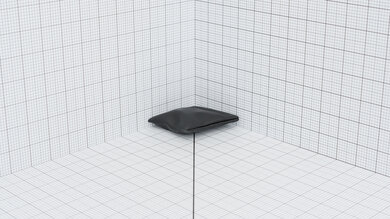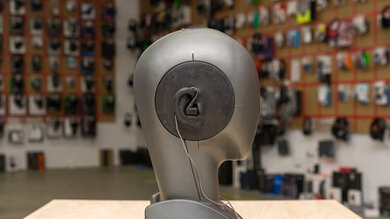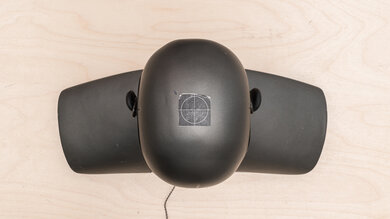The Sennheiser IE 200 are in-ear monitors (IEMs) with dynamic drivers, aimed at the lower mid-range audiophile market. What distinguishes them from other IEMs on the market is their unique design, which Sennheiser calls 'dual-tunable ear tips.' These ear tips can be positioned differently, depending on how much bass you like in your mixes, though this design has some practical limitations.
Our Verdict
The Sennheiser IE 200 are okay for sports and fitness, though this isn't their intended purpose. While they have a comfortable, stable in-ear fit, thanks to their deep fit and audio cables that hook over your ears, they can snag on something and pull the headphones off your head. The buds also lack an IP rating for water resistance or controls, so you'll need to use your device, which can take you out of the zone.
- Comfortable, stable fit.
- Very consistent audio delivery.
- Lacking IP rating.
- No controls.
The Sennheiser IE 200 are decent for travel. They're wired IEMs, so while they'll be great for listening to your favorite tunes, they lack features like ANC to help block out background noise when you're on the go or other nice-to-haves like controls. The passive isolation created by their in-ear fit is still sufficient to block out some mid- and treble-range noises, like subway announcements. Furthermore, they have a comfortable fit with a good selection of ear tips to dial in the fit, and their wired design means you don't have to worry about battery life.
- Comfortable, stable fit.
- Very consistent audio delivery.
- They struggle to block out bass range noise.
- No controls.
The Sennheiser IE 200 are middling for office work. They're comfortable and well-built but lack the versatility needed for work. They lack a microphone, so you can't take business calls unless you already have a standalone mic. That said, even though they rely on their passive capabilities to block out background noise, they can reduce some mid- to treble-range sounds like coworkers chattering. They don't leak much audio at high volumes; if you want to crank up your tunes, others around you won't hear it.
- Comfortable, stable fit.
- Very consistent audio delivery.
- They struggle to block out bass range noise.
- No mic.
- No controls.
The Sennheiser IE 200 are wired IEMs; you can't use them wirelessly.
The Sennheiser IE 200 are passable for wired gaming, particularly if you don't need built-in mic support since they don't already have a mic. Their bass range is tight with a good amount of rumble and punch, so sound effects like footsteps don't interfere with dialogue. Since they're closed-back in-ears, your audio seems like it's coming from inside your head rather than from the room around you. On the upside, these buds are comfortable enough for long gaming sessions and don't require an amp to power them.
- Comfortable, stable fit.
- Very consistent audio delivery.
- They struggle to block out bass range noise.
- No mic.
The Sennheiser IE 200 are a good choice for audio reproduction accuracy. They have a warm sound that complies well with our target curve across the entire frequency range, and there are few major peaks and dips that deviate from their overall profile. These in-ears offer a low-distortion performance, with low group delay and great matching between the L/R drivers.
- Comfortable, stable fit.
- Very consistent audio delivery.
The Sennheiser IE 200 are a decent choice for noise isolation, despite lacking an ANC system. They isolate via their passive fit and foam tips, which do a good job of blocking out mid- and treble-range noises, like background chatter and police sirens. That said, they struggle to block out bass-range sounds, like engine rumble or stomping neighbors. They also leak very little audio, so you can blast your music in quiet or densely packed environments without risking dirty looks from those around you.
- Comfortable, stable fit.
- Very consistent audio delivery.
The Sennheiser IE 200 are wired earbuds that don't have a built-in microphone.
- Comfortable, stable fit.
- Very consistent audio delivery.
The Sennheiser IE 200 are amazing at delivering audio consistently. Once you take the time to find a solid fit with the included ear tips, you'll be rewarded with consistent audio delivery.
- Comfortable, stable fit.
- Very consistent audio delivery.
Performance Usages
Changelog
-
Updated Jul 10, 2025:
In the Test Settings section of this review, we mistakenly listed the test connection as Bluetooth when it was actually conducted using a wired connection.
-
Updated May 21, 2025:
This review has been updated to Test Bench 2.0, which adds the following tests: Stereo Mismatch, Group Delay, Cumulative Spectral Decay, Harmonic Distortion, and Electrical Aspects. We've added new performance usages and updated the text throughout the Sound tests and side-by-sides.
- Updated May 14, 2025: We've converted this review to Test Bench 2.0, which updates our sound tests and adds performance usages. You can read more about this in our changelog.
-
Updated Dec 19, 2024:
Several Sound tests have been updated following Test Bench 1.8. There have also been text changes made throughout the review, including to the Usages and Product Comparisons to match these results.
Check Price
Differences Between Sizes And Variants
The Sennheiser IE 200 come in one variant: 'Black.' If you encounter another variant of these headphones, please let us know in the comments, and we'll update our review.
Popular Headphones Comparisons
The Sennheiser IE 200 are IEMs, so the main point of comparison between most products will come down to sound and your preferences. They have a balanced sound with a warm top-end compared to the MOONDROP Blessing 3, which otherwise sound similar except for having a brighter treble response. If you're looking at these buds for monitoring work, then the Sennheiser's sound is certainly suitable, especially with the somewhat recessed treble, which can alleviate ear fatigue over long sessions. While their housings are comparatively plasticky, if you have small ears, it might be easier to dial in a fit compared to the chunkier Moondrop shape, or other popular IEMs like the Shure SE215.
If you're looking for more headphones, check out our recommendations for the best in-ear headphones, the best headphones for music, and the best audiophile headphones.
The Sennheiser IE 200 and Meze ALBA are both single dynamic driver IEMs. The Sennheisers are slightly warmer, with a scooped low-mid treble, while the Meze have a frequency response that more closely resembles our target curve. You may prefer the Sennheiser's subdued treble if you're particularly sensitive to higher frequencies. The Sennheiser also come with foam tips which help the earbuds block out more noise than the Meze. That said, the Meze are made from premium materials rather than plastic and are more comfortable for most people.
The MOONDROP Aria and Sennheiser IE 200 have slightly different sounds, so you may prefer either IEM, depending on your needs. The MOONDROP deliver more bass, which is good if you like to listen to genres like EDM and hip-hop. They're also more comfortable, albeit chunky. The Sennheiser's sound is very balanced even if vocals and instruments are a bit more veiled, and they block more noise. Their cabling and connectors are more durable, even if the housings are plasticky compared to the metal Moondrop housings.
The Sennheiser IE 200 have a similar sound to the Shure SE215. While the Sennheiser have a warm sound, their treble range isn't quite as recessed as the Shure. Both buds are comfortable and have solid passive noise isolation performances, though the Shure are slightly better built. Both are viable choices for on-stage monitoring or as entry-level IEMs, and choosing between them could come down to small details and personal preference. Some might prefer the Sennheisers' foam tips over the Shures' silicone ones, for example.
If you're a fan of somewhat excited tunings, you'll want to choose the MOONDROP Blessing 3 over the Sennheiser IE 200. The MOONDROP deliver more thump and rumble, along with more low-treble presence, which can help vocals cut through dense mixes. That said, the Sennheiser are still worth considering if you're monitoring a show since their recessed low-treble can help take the edge off your mixes, lessening ear fatigue over long listening sessions.
Test Results

These buds allow you to adjust the ear tip positions between standard and outer/open for slightly different frequency responses. In standard positioning with the foam ear tips, they have a warm sound signature.
While it's possible to switch the buds into an outer/open position, once you insert the tips into your ear (or into a testing rig), this outer position can shift into the standard position. Subjectively, it took some time to achieve a good fit with this setting. While we noticed there was less bass and a little more treble, the seating was awkward, causing us to adjust the fit back to the standard position.
These buds have outstanding frequency response consistency. Once you get a good fit using the assorted tips included in the box, you'll achieve consistent bass and treble delivery.
The Sennheiser IE 200 have incredible bass target compliance. Their low-end response mirrors our curve extremely well, rendering a smooth bass reproduction across the range that supplies a tight and punchy sound.
The mid-range profile's target compliance is fantastic. Overall, the response in this range follows our target curve well, resulting in present and clear-sounding instruments and voices like the piano in Claude Debussy's Arabesque No. 1. However, there's a minor dip in the mid-mid, which nudges vocals and instruments down a little in the mix. At the same time, a boost to the high-mids adds an intensity that can sound somewhat honky on searing guitar solos.
These buds have excellent target compliance in the treble range. The low treble is a bit carved out here, which veils the clarity of vocals and instruments. Sibilants like hi-hats are still present but slightly subdued. The recessed treble can help lessen ear fatigue if you're listening to tracks for long periods. Meanwhile, a boost in the highest registers adds brilliance to the mix.
These buds' peaks and dips performance is good, which means that the headphones can control their sound profile quite well. Their frequency response is very smooth and controlled in the bass and mids. The high-mids have a minor peak that adds a little intensity to lead guitars. A small dip in the low-to-mid-treble range hurts vocal intelligibility slightly. The mid-treble has a peak, too, causing sibilants like cymbals to be piercing, following a dip and sharp peak in the highest frequencies, which can sound hissy if your ears are sensitive.
The Sennheiser IE 200 have a great stereo mismatch performance, indicating tight tolerance between the L/R drivers. There's excellent matching when it comes to frequency and amplitude, with only very subtle variations in the frequency response in the treble range. While the drivers are less well-matched when it comes to phase, with some slight mismatches in the treble range, it's still not enough to create any audible phase cancellations.
The group delay performance is good, and the response falls below the audibility threshold across the entire range. Bass reproduction is tight, with well-defined transients, and the treble range sounds transparent.
These in-ears have excellent harmonic distortion performance. The sound has no audible coloration, both at 94 dB/SPL and 104 dB/SPL, so even the most sensitive listeners won't find that distortion affects their listening experience.
You won't need an external amp to drive these in-ears, and they're capable of reaching loud listening levels with mobile end devices, like mobile phones or laptops.
These are the settings used to test these headphones, and our results are only valid when used in this configuration.
These buds have a comfortable fit. They come with several pairs of ear tips, in silicone as well as foam, to help you get the best fit possible. They don't put much pressure inside your ears; once you put them on, you won't feel them. The ear hooks are malleable, too, which makes it easy to fit them to your ears, and it feels good on the skin. You can even lay on your side with the buds in your ear without experiencing significant discomfort. On the cable is a clear plastic adjustable slide, so you can adjust the amount of cable between both earbuds. On the downside, the buds' housing can rub up against your concha when you're inserting the buds.
The build quality of these buds is good. The buds are plastic, so they're lightweight yet solid; you can accidentally drop them without breaking them. Like most IEMs, you can detach their braided cable, making it easy to swap it out for something with a different connector, although it's worth mentioning that MMCX cables aren't cheap. The default cable is also made of kevlar, which is a synthetic, incredibly sturdy material.
The Sennheiser IE 200 have great stability. Since they have a deep in-ear fit and their cable loops around your ear, they won't move around or fall out if you want to headbang to a track. The cable doesn't disconnect as easily as the Sennheiser IE 40 PRO, either. They aren't designed for sports, though, and the cable can easily snag on something, yanking the buds from your ear.
These buds have a decent noise isolation performance when it comes to full-range noise, even though they don't have an active noise cancelling (ANC) system, thanks to their foam ear tips filling your ear canal. While they make a minor dent in bass-range noise like the low rumbles of bus engines, they do a better job of cutting down mid- and treble-range noise, like people talking and the high-pitched hum of computer fans.
Regarding common scenarios, these headphones have much more trouble with low-pitched sounds. While you'll have some degree of noise isolation, whether you're on a plane, in an office, or walking down a street, it's not enough to fully block out all sound.
These buds' leakage performance is fantastic. Leakage is fairly spread out but quite minor. Even if you crank up your tunes in a moderately noisy environment like an office, others around you won't hear it.
These buds come with a detachable audio cable with MMCX connectors going into the buds and a 1/8" TRS connector for your device. Latency is negligible when using it, which ensures that your audio and visuals are in sync if working on delay-sensitive content like editing video.
These buds can only connect to PCs via analog. They don't have a mic, so you can only receive audio.
You'll only get audio when connecting these buds to your PlayStation controller's AUX port.
You can connect these headphones to your Xbox console for audio-only support by plugging the cable into your controller's AUX port.














